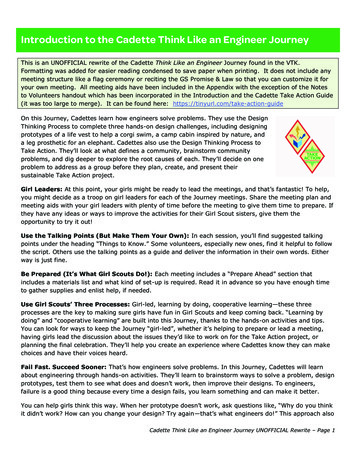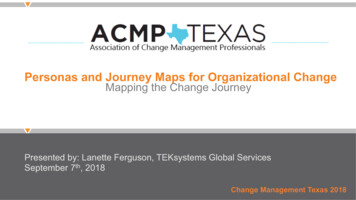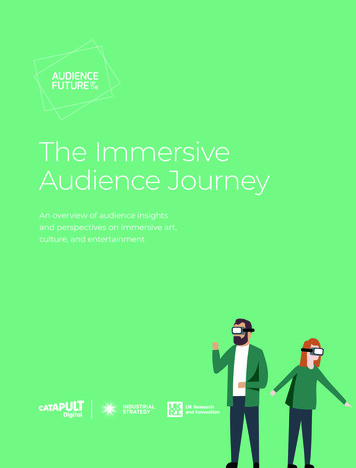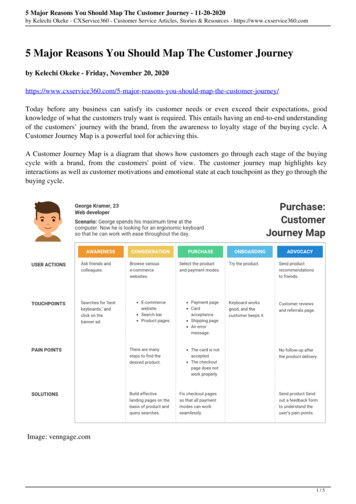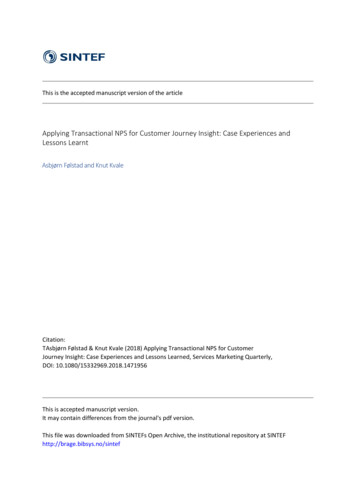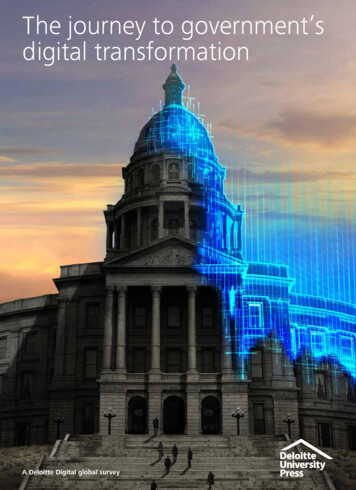
Transcription
The journey to government’sdigital transformationA Deloitte Digital global survey
Deloitte Digital is a digital consulting agency that brings together the creative and technologycapabilities, business acumen, and industry insight needed to help transform our clients’businesses. Learn more at www.deloittedigital.com.
A Deloitte Digital global surveyAbout the authorsWilliam D. EggersWilliam Eggers, a leading authority on digital government, is responsible for research and thoughtleadership for Deloitte’s Public Sector industry practice. He is the author of eight books, includinghis newest, co-authored with Paul Macmillan, The Solution Revolution: How Business, Government,and Social Enterprises are Teaming up to Solve Society’s Biggest Problems (Harvard Business Press,September 2013). The book, which The Wall Street Journal calls “pulsating with new ideas aboutcivic and business and philanthropic engagement,” was on many ten best books of the year lists. Hisbooks have won numerous awards including the 2014 Axiom book award for best book on business theory, the Louis Brownlow award for best book on public management, the Sir Antony Fisheraward for best book promoting an understanding of the free economy, and the Roe Award for leadership and innovation in public policy research. He coined the term “Government 2.0” in a book ofthe same name. He can be reached at weggers@deloitte.com or on Twitter @wdeggers.Joel BellmanJoel Bellman is a partner with Deloitte in the United Kingdom, and Deloitte’s global lead for digitaltransformation in the public sector. He has worked extensively with central and local governmentorganizations in the United Kingdom and elsewhere, leading programs that include building digitalsolutions, designing digital operating models, and delivering complex policy goals with innovativeservice designs. He is a regular author of blogs and publications covering digital and service transformation, including The ascent of digital: Understanding and accelerating the public sector’s evolution,Making digital default: Understanding citizen attitudes, A mobile enabled government, Red ink rising:Navigating the perils of public debt, and Choosing fewer channels: Public service delivery options in anage of austerity. He can be reached at jbellman@deloitte.co.uk or on Twitter @joelbellman.
The journey to government’s digital transformationContentsIntroduction 1Characteristics of a digitally maturing governmentBarriers and challenges to digital transformation Accelerating digital transformationKey questions public leaders need to considerConclusion 29Appendix 30Endnotes 35 22412
A Deloitte Digital global surveyIntroductionIN the coming decade, several factors—anaging population, the rise of Millennials,budget shortfalls, and ballooning entitlementspending—could reshape the way government delivers services. But the introductionof new digital technologies is likely to be themost important factor of all. Indeed, governments from Torontoto Seoul are in themidst of a historic (andfrequently wrenching)transformation as theyabandon analog operating models in favorof digital systems.Truly transforminggovernment throughthe power of digitaltechnologies will be ajourney. We surveyedmore than 1,200 government officials fromover 70 countries on digital transformationand interviewed another 140 government leaders and outside experts.* Overwhelmingly, theyreported that digital technologies are having amajor impact on government: Three-fourths ofthe respondents told us that digital technologies are disrupting the public sector; nearly all(96 percent) characterized the impact on theirdomain as significant (figure 1).Another key finding of the global surveythat stands out is that governments are at verydifferent stages in thisjourney. While a smallpercentage are whatwe consider “maturing,” the overwhelmingmajority are still in theearly or developingstages of the digitaltransformation journey (sidebar). In fact,when asked about theirorganization’s digitalcapabilities, only about30 percent assessedtheir digital capabilities as ahead of their public sector peers; nearly70 percent said they lagged behind the privatesector (figure 4).Truly transforminggovernment throughthe power of digitaltechnologies will bea journey.Figure 1. Impact of digital76%To what extent do you perceivedigital technologies aredisrupting the public sector?18%35%23%16%8%96%How much has your domain area37%been impacted by digital trends?37%39%20%2%2%Great extentModerate extentSmall extentNot at allDon’t knowGraphic: Deloitte University Press DUPress.com*More than half of the survey questions were sourced from the 2015 MIT Sloan Management Review and Deloittedigital business study. For more details, please refer to the appendix.1
The journey to government’s digital transformationDIGITAL MATURITY MODEL EXPLAINEDDigital maturity refers to the extent to which digital technologies have transformed an organization’sprocesses, talent engagement, and citizen service models. We estimated the level of maturity based onresponses to survey questions that broadly fell under three categories—people, processes, and preparedness(figure 2).Figure 2. Maturity frameworkDIGITAL MATURITYPEOPLEPROCESSESPREPAREDNESSDigital know-how; ability ofleadership; workforce skills; avenuesto upskill; enabling talentInnovation and collaboration; citizenservice; citizen involvement; opensource usage; enabling procurementStrategy articulation; investmentreaction and response to digitaltrends; capability benchmarkingGraphic: Deloitte University Press DUPress.comBased on our digital maturity estimation framework (described in the appendix), we classified respondentorganizations into three categories: “early,” “developing,” and “maturing” (figure 3). The distribution ofdigital maturity among government agencies remains more or less similar across geographical regions.1 Wehave been careful to refer to governments as “digitally maturing” rather than “digitally mature” because weare still at the early stages of the journey to digital transformation and no governments have yet to reach theend state.Figure 3. Global digital maturity c: Deloitte University Press DUPress.comFigure 4. How do you think your organization’s digital capabilities compare to:2%Other public sectororganizations (n 1204)5%3%25%Private sectororganizations (n 957) 4%25%Don’t knowFar behindBehind38%27%44%20%About the sameAheadFar ahead6%1%Graphic: Deloitte University Press DUPress.com2
A Deloitte Digital global surveyFigure 5. Response to digital trends1%I am confident in myorganization’sreadiness to respondto digital trends8%I am satisfied with myorganization’s currentreaction to digitaltrends8%31%24%33%21%32%4%32%5%1%Don’t knowStrongly disagreeDisagreeNeither agreenor disagreeAgreeStrongly agreeGraphic: Deloitte University Press DUPress.comMoreover, respondents reported low overallsatisfaction with their organization’s current reaction to digital trends and confidencein its readiness to respond to digital trends(figure 5). Even in the countries with thehighest percentage of satisfied respondents—New Zealand, Ireland, and Belgium—onlyabout half the respondents said their organization’s response to digital trends could beconsidered satisfactory.Another interesting finding concernswhat’s actually driving digital transformationin government. Cost and budget pressuresand citizen demands are far and away the twoprimary drivers, accounting for 75 percentof responses, whereas government directives drive only 14 percent of agencies. Theseresults, however, differ vastly across countries.At one end is the United Kingdom, wherecost and budget pressures drive 56 percent ofpublic sector organizations; at the other end isCanada, where 64 percent of government bodies cite citizen demands as the primary driverof digital transformation.In the sections that follow, we explorefindings related to the characteristics of publicsector organizations at the forefront of usingdigital technologies to transform the way theyfunction. We then look at the primary barriers to digital transformation. Finally, we layout a set of strategies that government leaderscan employ to successfully navigate the digitaltransformation journey.3
The journey to government’s digital transformationCharacteristics of a digitallymaturing governmentWHAT separates digital leaders from therest is a clear digital strategy combined with a culture and leadership poised todrive the transformation. This should not besurprising given that the history of technological advancement is strewn with examplesof organizations focusing on technologieswithout investing in organizational capabilities that ensure their impact. Governmentshave been particularly prone to this trap.Case in point: Early efforts to put computers in schools failed to result in performanceimprovements because they weren’t accompanied by fundamental changes in teachingmethods that suited the technology. The failedimplementation of enterprise resources inmany governments is another classic exampleof expectations falling short due to a failureto change processes or build cultures thatfostered change.FACTORS THAT INFLUENCEDIGITAL TRANSFORMATIONIn addition to the survey, we conductedmore than 140 interviews with publicsector leaders involved in digitaltransformation. From the interviewsemerged five factors shaping digitaltransformation: strategy, leadership,workforce skills, digital culture, anduser focus (table 1). We examined howorganizations at each level of maturitybehave with respect to these five factors.Digitally maturing organizationshave a clear strategy aimed atfundamental transformationAn organization’s digital maturity is influenced, to a great degree, by its digital strategy.Table 1. Characteristics of a digitally maturing organizationEarlyDevelopingMaturingStrategyAimed at cost reductionAimed at improving customerexperience and decision makingAimed at fundamentaltransformation of processesLeadershipLacks awareness and skillsDigitally awareDigitally sophisticatedWorkforcedevelopmentInsufficient investmentModerate investmentAdequate investmentUser focusAbsentGaining tractionCultureRisk averse; disintegratedRisk tolerant; accommodatesinnovation and collaboration4“Central” to digital transformationRisk receptive; fosters innovationand collaboration
A Deloitte Digital global surveyFigure 6. Strategy by maturityAmong respondents from government agencies at the early stages of maturity, only 14percent say that their organizations have aclear and coherent digital strategy (figure 6).In case of more digitally mature organizations,the number grows sixfold, to 86 percent.“Lack of strategy” is the leading barrierimpeding early-stage organizations from taking full advantage of digital trends. However,it does not appear among the top five barriers for digitally maturing agencies (table 2).As early-stage organizations mature, lack ofstrategy falls away and barriers become muchmore about portfolio management, funding,and handling cyber security.Maturing organizations havea digital strategy aimed atfundamental transformationThe potential impact of a digital strategyis largely determined by its intent and reach.Rajendra Kumar, joint secretary at India’sDepartment of Electronics and InformationTechnology, says about the agency’s key initiative: “The goal of the Digital India strategyis to transform the governance of the entirecountry through digital interventions. The ideais that every domain of government should beable to deploy and use digital technologies ina manner that can increase the service-levelstandards, improve interactions with citizens,and raise efficiency.”2In contrast to such ambitions, our researchfound that digital strategies at early-stageOrganization has a clear and coherent digital strategy (% s have more of an operationalGraphic: DeloitteUniversity Press DUPress.comfocus, such as increasing efficiency.Only abouta third cite transforming their business modelas an objective.Digital technologies play a role in helpingmaturing organizations achieve strategic goals.Nearly 81 percent of respondents say that theiragency’s digital strategies drive transformationof business processes. “Transformation meansmore than fixing websites. It goes deeper thanthat, right into the organizations behind thewebsites,” explains Mike Bracken, former chiefdigital and chief data officer for the UK government. “There’s a logic to it: Digital servicedesign means designing the whole service,not just the digital bits. If you’re redesigning aservice, you need to think about the organization that runs it.”3Table 2. Top barriers by maturityEarlyDevelopingMaturingLack of overall strategyToo many competing prioritiesToo many competing prioritiesLack of understandingInsufficient fundingInsufficient fundingLack of entrepreneurial spirit, willingnessto take risksSecurity concernsSecurity concernsToo many competing prioritiesLack of organizational agilityInsufficient technical skillsLack of organizational agilityLack of an overall stratetgyLack of organizational agility5
The journey to government’s digital transformationTable 3. Objectives of strategy by maturityEarlyDevelopingMaturingIncrease efficiency64 percent88 percent95 percentImprove customer/citizen experienceand engagement, and transparency55 percent89 percent94 percentCreate or access valuableinformation or insightsfor innovation33 percent68 percent85 percentCreate or access valuableinformation or insights toimprove decision making42 percent76 percent83 percentFundamentally transform ourorganization processes and/or organization model34 percent66 percent81 percentThe importance that organizations place onusing digital technology to improve innovation and decision making also varies by digitalmaturity level. Approximately 40 percent ofrespondents from early-stage agencies say thattheir digital strategy aims to boost innovation and improve decision making. In digitallymaturing organizations, the number more thandoubles to 85 percent (table 3).It is surprising to note that across domains,defense has the lowest percentage of respondents (46 percent) who list “fundamentallytransforming their organization processes ormodels” as a goal for their digital strategies.Similarly, public sector executives increasingly expect HR functions to adapt andembrace digital solutions to tackle workforcemanagement challenges. But only 40 percentof respondents from the HR function reportfundamental transformation of processes asa strategic objective. Furthermore, less than30 percent cite innovation as an objective oftheir digital strategy. These ratios are the lowestacross all functions surveyed—a real concern,considering the difficulties governments currently face in acquiring needed digital skills fortheir workforce.6Digitally savvy leadershipis a game changerThe exponential changes that drive digital transformation challenge the establishedmodels of leadership and governance. Beforethe ascent of digital technologies, new projectscould be assessed through exhaustive analysis, investment decisions could be based oncost-benefit guidance, and the end destination of most plans was a fixed point. In thenew digital era, leaders are required to makedecisions more quickly in the face of a constant evolution in the art of the possible. Inthis challenging environment, just 38 percentof survey respondents believe their leadershiphas sufficient skills for digitally transformingpublic services.For public sector agencies across the globe,the hierarchies and governance structures areoften more pronounced than in the privatesector. More than half of the respondents saya single person or group leads their organization’s digital agenda. Nearly 80 percent of theseleaders are heads of various departments oragencies in governments, C-suite equivalents,or executives just below the C-suite level(figure 7).
A Deloitte Digital global surveyFigure 7. Digital agenda is led from the topDoes any single person or group have theresponsibility to oversee/manage yourorganization’s digital strategy?What is the highest level/rank of individuals whose job itis to oversee/manage your organization’s digital ogram lead/manager16%Yes51%Executivesbelow C-suite34%Staff2%Don’tknow3%C-suite25%Graphic: Deloitte University Press DUPress.comEmployees in digitally maturing organizations are more confident in their leaders’ability to navigate the digital game. More than85 percent of respondents from these agencies say their leaders have sufficient skills tolead the digital strategy; nearly 96 percent saytheir leaders understand digital trends andtechnologies. By contrast, only a small fraction of respondents from early-stage organizations have the same level of confidence:Just 4 percent think their leaders possesssufficient skills, and 7 percent say their leaders possess sufficient understanding of digitaltechnologies (table 4). This was a recurringtheme in our interviews with governmentexecutives: Organizations at higher levels ofmaturity invariably have leaders with the skillsand understanding to navigate the digitaltransformation process.More than 70 percent of respondents fromthe information, communication, and technology (ICT) domain, and more than 65 percentfrom the finance and revenue department,say their leadership has sufficient skills to leadtheir organization’s digital strategy. Comparethis with the defense domain, where more thanhalf the respondents express little confidencein their leadership’s understanding of digitaltrends and technologies. An overwhelmingmajority of respondents from the health care(89 percent), environmental (88 percent), economic development (86 percent), and law andjustice (85 percent) departments also identifyleadership as a challenging area with regard tothe agency’s digital transition.Table 4. Leadership capabilities by maturityEarlyDevelopingMaturingConfident about leadership’sunderstanding of digital trendsand emerging technologies7 percent60 percent96 percentLeadership has sufficient skills tolead organization’s digital strategy4 percent42 percent86 percent7
The journey to government’s digital transformationFigure 8. Investment in workforceprovides the resources or opportunities toOrganization provides resources or opportunities to obtain thebuild the necessary skills to benefit from digitaltrends. Among less mature organizations, theright skills to take advantage of digital trends (% agree)number drops to just 6 percent (figure 8).77% The presence or absence of a digitally savvyleadership plays a big role in whether the organization takes steps to upskill its workforce.Leaders who understand digital trends andtechnologies are almost three times more likelyto provide organizational support to theirworkforce to help them build digital skills,35%compared to those who lack that understanding. Further, 43 percent of respondents whosay their leaders understand digital trendsand technologies believe that their agency’s6%employees have sufficient skills to execute thedigital strategy. Among organizations that lackDevelopingMaturingconfidence in their leaders’ understanding ofFigureEarly9. Leadership and workforceskillsdigital trends, this figure falls to just 24 percentGraphic:DeloitteUniversityPress DUPress.com(figure 9).49%43%Early-stage organizations lack anunderstanding of digital trends24%17%Leadership understandsdigital trends andtechnologiesLeadership does notunderstand digital trendsand technologiesOrganization provides resources to help employees build the right skillsEmployees have sufficient skills to execute digital strategyGraphic: Deloitte University Press DUPress.comDigitally maturingorganizations build skills torealize their digital strategyMaturing digital organizations invest inbridging skill gaps. More than 77 percent ofthese respondents report that their agency8When asked what is impeding their organization from taking advantage of digital trends,nearly a third of early-stage leaders point to“lack of understanding.” Less digitally matureagencies, in particular, lag when it comes tothe ability to conceptualize how digital technologies can impact the business. Nearly 51percent of respondents from these organizations rank this among the top three skills thatneed bolstering.Digitally maturing organizationshave greater user focusA variety of factors may guide a publicsector organization’s digital transformationjourney, but it’s clear that citizen needs becomemore prominent as an agency moves up thematurity curve. Indeed, maturing organizations are nearly twice as likely as early-stageorganizations to be driven by customers/citizens’ demand for digital transformation(figure 10).
A Deloitte Digital global surveyA laser focus on using digital technologiesto improve the citizen experience helps maturing organizations improve service delivery.Respondents from all maturing organizationsalmost unanimously report that digital technologies and capabilities enable their employees to work better with customers or citizens;in early-stage agencies, only a little over halfthe respondents say so. Additionally, 94 percent of maturing organizations have a digitalstrategy aimed at improving customer/citizenexperience and engagement, compared to only55 percent of early-stage organizations. Thisclearly separates the leaders from the laggards;agencies moving ahead on the maturity curvehave the “citizen” at front and center in theirdigital strategy. Not surprisingly, maturingagencies also say overwhelmingly that digitaltrends are improving their citizen/customerservice quality (figure 11).Digitally maturing organizationschallenge cultural normsDigitally maturing government organizations are characterized by a culture that favorsdigital transformation: They nurture innovation, foster collaborative work environments,and maintain a positive attitude toward risktaking. And innovation and collaboration arenot always a product of digital technologies—they can also be fostered through digitallyfriendly project-management methods such asAgile. Gavin Till, CIO of the Christchurch CityCouncil (New Zealand), explains, “Our collaboration is really more through adopting theAgile Scrum methodology, which requires a lotmore interactions and collaboration as you goalong and develop services. We haven’t utilizedany technology to help collaboration, it comesfrom the virtue of Agile Scrum methodology.”4Taking risk is becoming acultural norm for digitallymaturing organizationsDigitally maturing public sector organizations are more adept at taking risks—moreFigure 10. Drivers of digital transformation by lyDevelopingCost and budgetpressuresCustomer/citizen demandsFederal/centralgovernment agenciesOtherMaturingDigital maturity ofother agenciesGraphic: Deloitte University Press DUPress.comFigure 11. Digital and customer/citizen service100%90% 89%51%94%99%84%55% 54%EarlyDevelopingMaturingDigital technologies and capabilities enable employees at myorganization to work better with customers/citizensImproving customer/citizen engagement/experience and transparencyis an objective of organization’s digital strategyDigital trends are improving customer/citizen service qualityGraphic: Deloitte University Press DUPress.com9
The journey to government’s digital transformationFigure 12. Attitude to risk by maturityHas the transition to digital altered the organization’s attitude torisk to make it more willing to experiment and adopt an agile,“fail fast, fail quickly” approach? (% yes)56%29%Innovation and collaboration thrivein digitally maturing organizations10%EarlyDevelopingMaturingGraphic: Deloitte University Press DUPress.comFigure 13. Culture and digital trendsDigital trends are improving my organization’s innovativeculture/collaborative culture (% agree)96%72%32%97%72%35%EarlyDevelopingInnovative cultureMaturingCollaborative cultureGraphic: Deloitte University Press DUPress.com10willing to experiment with agile, “fail fast, failquickly” approaches. They are five times morelikely than early-stage agencies to alter theirattitude toward risk taking (figure 12).Also, early-stage organizations cite a “lackof entrepreneurial spirit” and “willingness totake risks” among the most important barriersto taking advantage of digital trends.Digitally maturing agencies are better positioned to achieve the benefits of collaboration.Nearly all (98 percent) maturing organizationssay that digital technologies and capabilities facilitate employees working better witheach other.Maturing agencies do see a big shift in theirinnovative and collaborative culture due todigital trends: They are nearly three times aslikely as early-stage organizations to report animprovement in their innovative and collaborative culture owing to digital trends (figure13). A senior public sector IT executive fromAustralia believes that digital transformation isabout attitude and user experience rather thanthe tools involved. As he says, “In digital transformation, there’s a lot more about businessprocesses and user experiences and attitudesand things like that than there is around thetools involved. All the tools in the world won’tmake you do these if you’re not thinking inthat mindset.”5
A Deloitte Digital global surveyWe analyzed the performance of the primary domains of the public sector across these five factorsinfluencing maturity. The results are summarized below:StrategyDomainsLeadershipClear & coher- Leadership’sent digitalunderstandstrategying of digitaltrendsLeadership’sskills tolead digitalstrategyWorkforceInvestmentin workforceskillsWorkforceskills to execute digitalstrategyUser focusCustomer/citizen demandsas driver ofdigital transformationObjectiveof strategyto improvecustomer/citizenexperience &engagement,andtransparencyDigital cultureCo-creationof digitalservicesMore willingto experimentand adopt anagile, fail fast,fail quicklyapproachto ingcollaborativecultureCentral ironmentFinance &revenueHealth careHighereducationICTInternationalaffairsLaw andjusticeSocial servicesTransportation Above average Below averageNOTE: Classifications in the table are based on the ratio of respondents who answeredcorresponding questions positively. Ratios higher than global average were classified as“above average” and those lower than global average were classified as “below average.”While our survey did not capture primary data on why some domains perform better than others, we’vemade some inferences based upon our experiences working with and within the public sector:Digital culture is weaker in the defense, energy, and law and justice sectors. These are all sectorsthat focus on critical public services where there is low tolerance for error, and where small operationalerrors can have damaging long-term impact. Our survey found that they are less willing to experiment andslower to innovate and collaborate using digital technologies, which could be because they have fosteredrisk-averse cultures that make innovation and experimentation harder to achieve.Workforce digital maturity is weak in some of the sectors that deliver professional services,particularly higher education, health care, and social services. These are sectors where frontlineservice delivery relies on trained professionals using their judgment and operating with a level ofindependence. Our survey found that they are slower to invest in workforce skills to execute digital strategy,which could be because these sectors traditionally place a high value on professional judgment, subjectmatter knowledge, and interpersonal skills rather than organizational, digital, or transformation skills.Levels of user focus are higher across sectors where the public service itself is about deliveringknowledge services to citizens/customers—in particular, information technology, education,and higher education. This is hardly surprising—these users are most likely to have evolving and changingdemands, making user-centricity a critical capability of organizations in these sectors.11
The journey to government’s digital transformationBarriers and challenges todigital transformationOUR survey asked respondents to identifythe main barriers to digital transformation. The results show two barriers standingout, with nearly 40 percent of respondentsciting them as the most significant: insufficientfunding and too many competing priorities(figure 14).Many public bodies struggle to fund corecitizen services, let alone investments in digitalinitiatives—even though digital transformationis widely recognized as a route to substantialcost savings. While 82 percent of organizationsperceive digital technologies as an opportunity,only 44 percent managed to increase investment in those initiatives over the last fiscal year(figure 15).Leaders trying to drive change always facecompeting priorities—in particular, manystruggle to find a balance between transformation and “keeping the lights on.” Public bodiesthat successfully navigate their goals tend tohave coherent, realistic strategies and wellunderstood business cases.Apart from inadequate funding and toomany competing priorities, maturing organizations report security as a major barrier. Forearly-stage agencies, the absence of an overallstrategy—coupled with a lack of understandingof digital trends—is a key barrier.We asked survey respondents to rank theareas of digital transition that they deemedthe most challenging to manage. Overall,Figure 14. Top barriers that impede the organization from taking advantage of digital trends41%Too many competing prioritiesInsufficient funding37%32%Security concerns31%Lack of an overall strategy27%Lack of organizational agil
William D. Eggers William Eggers, a leading authority on digital government, is responsible for research and thought leadership for Deloitte's Public Sector industry practice. He is the author of eight books, including his newest, co-authored with Paul Macmillan, The Solution Revolution: How Business, Government, and Social Enterprises are Teaming up to Solve Society's Biggest Problems .






